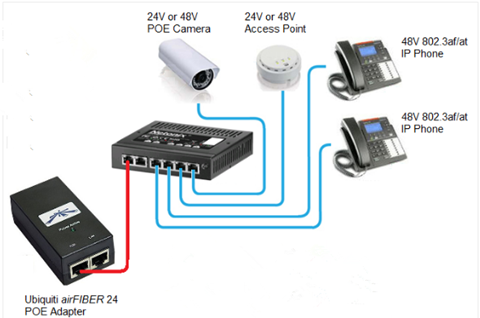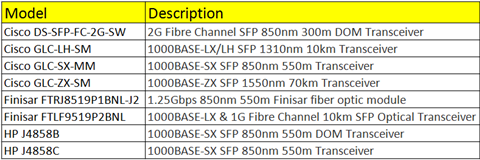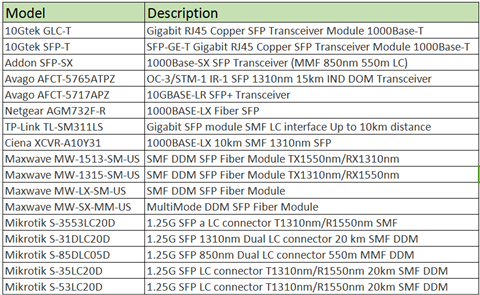Compatible Gigabit SFP Optical Transceiver for Netonix WISP Switch
petak , 05.05.2017.The Netonix WISP switch is the managed PoE Gigabit Switches with several Gigabit Ethernet RJ45 and SFP ports. Compared with Ubiquiti Networks Edgeswitch switches (40C), Netonix WISP switches was designed with a rugged chassis and extended operating temperature (-25 to 55C), which is more suitable for outdoor deployment. Furthermore, the ability to power AirFibers is the unique feature of WISP switches. This article will describe WISP switches in detail and help you choose the compatible Gigabit SFP optical transceivers for Netonix WISP switches.
Netonix Gigabit WISP Switches
WISP switches are the Netonix Gigabit switches with the performance of Non-Blocking Throughput Switching and software configuration passive PoE. The Netonix WISP switches feature the ability to power many popular 24V, 48V/50V passive PoE devices from manufacturers including Ubiquiti Networks airMAX™, UniFi™, SAF™, MIMOSA™, Ligowav™, and airFIBER™ product lines. There are WS-24-400A, WS-24-400B, WS-12-250A, WS-12-250B, WS-12-250-DC, WS-12-250-AC, WS-12-DC, WS-10-250-AC, WS-8-250-DC, WS-8-250-AC, WS-8-150-DC, WS-8-150-AC, and WS-6-MINI.

Note that: the No. “6”, “8”, “10”... in those model refers to the numbers of port. And “150” and “250” means the max power consumption. The above image shows the simple home network setup using WS-6-MINI switches.
Optical Transceiver Tested to Work Well in WISP Switches
According to Netonix community, the SFP (optical module form factor) Gigabit Ethernet ports on WISP switches accommodate a full range of SFP optical transceiver modules, including SFP 1000BASE-T, SFP 1000BASE-SX, SFP 1000Base-LX/LH, SFP 1000BASE-ZX, SFP 1000BASE-BX-D, SFP 1000BASE-BX-U, SFP 1000BASE-EX. The following SFP optical transceivers are reported to be working fine on WISP switches.
Major Branded Optical Transceivers For WISP Switches


Compatible Optical Transceivers for WISP Switches
Fiberstore compatible optical transceivers are reported to work well on Netonix WISP switches. The following table lists the detailed information about the compatible optical transceiver modules on WISP switches.

Conclusion
The Netonix WISP switches were designed to be part of the Small Business or home networking products that work together as part of proven, fully integrated, easy-to-use small business solution. These switches support a huge number of Gigabit Ethernet SFP optical transceivers. All these high-quality fiber optic transceivers can be found on FS.COM for competitive prices. FS.COM is committed to provide free shipping in USA, Mexico and Australia.
Oznake: compatible gigabit SFP optical transceiver, SFP optical transceiver, Fiberstore SFP-GB-GE-T, GLC-BX-U, GLC-BX-D, GLC-SX-MM, GLC-ZX-SM, GLC-T
komentiraj (0) * ispiši * #
Cat6 vs. Cat6a Cable
petak , 15.04.2016.Probably network designers who work in telecommunication industry are often met such questions in cabling installation: which cable type performs better and why is it. Some cabling installers even argue against each other and keep their own instances on the better cable type that they think is suitable for the projects. Cat6 and Cat6a are just in this case, since the selection of them leads to different opinions among users. Some prefer to the Cat6, while some choose the Cat6a. In this article, several aspects will be discussed to differ these two kinds, with the aim to help you choose the right cable type for your networking use more quickly.
Both Cat6 and Cat6a are unshielded twisted pair UTP or shielded twisted cables, suitable for Gigabit Ethernet (GbE) and other network physical layers. They are backward-compatible with Cat3, Cat5 (a cable type widely used in GbE applications in combination 1000BASE-T SFPs, eg. Cisco SFP-GE-T). Each deploy four twisted pairs in a common jacket to transmit data by using the same style RJ-45 jacks and plugs. When compare Cat6 with Cat6a, it seems that the only difference lie in the single lowercase letter—a standing for “augmented” that sets the two apart. However, differences are not limited to this one point.
Cat6 vs. Cat6a: Physical Properties
Firstly, Cat6 and Cat6a have their own identifiers printed on the cable jacket itself, so this provides a quick way to tell them apart. Secondly, Cat6a is thicker and bulkier than Cat6 just looking from outside. Thirdly, in terms of wiring structure, Cat6 is made of tightly twisted pairs of copper wires with extra insulation to reduce crosstalk, while Cat6a takes things even further by additionally twisting each pair around a flexible central plastic support.
Cat6 vs. Cat6a: Speed & Distance
It’s known that Cat6 and Cat6a are all designed for GbE and other standard network protocols, both being suitable for 10BASE-T, 100BASE-TX, 1000BASE-T, and 10GBASE-T. (Certainly, 1000BASE-T standard can also operate over Cat5 cables, such as GLC-T SFP.) At first sight, there is no big difference. But the real points come when you consider their transmission speed and distance. Cat6 cable is rated for 250MHz, and when used for 10GBASE-T applications, the maximum length maximum length ranges from 33m to 55m. In contrast, Cat6a doubles that capability by performing at up to 500MHz, allowing 10GBASE-T to be run over longer distances of up to 100m.
Cat6 vs. Cat6a: Crosstalk
Crosstalk happens when a signal from one channel or circuit interferes with another channel or circuit's signal. Cat6a has a lower-level crosstalk than Cat6a. Such reduction owes to alien crosstalk (AXT), which refers to the cables interfering with the signals of other cables in close proximity. This AXT pehnomenon is significant in Cat6 which is exposed to high frequencies, but quite low in Cat6a.
Cat6 vs. Cat6a: Durability
Due to the new central column support and ubiquitous shielding, Cat6a is much heavier and bulkier than the Cat6 just as what has been mentioned above. Cat6a takes more room, so that cable trays will not hold nearly as many Cat6a cables as they can for Cat6 cables.
Although Ethernet cables may seem sturdy on the outside, their inner parts are so fragile. To put in in another way, it is ill-advised to bend cables or cause winding of cables too much, as this can damage wiring and lead to performance degradation. Because of their bulkiness, Cat6a cable has a smaller bend radius than Cat6 cable.
Cat6 vs. Cat6a: Cost
Compared with Cat5e cables, Cat6 and Cat6a cables are more expensive, which mainly dues to the cabling length. But the cost differences between Cat6 and Cat6a cables are not so distinctive, or in other words, relatively small. For example, 5m Cat6 twisted pair patch cable sells at US$ 6.10 in Fiberstore, and the same length of Cat6a twisted pair patch cable in Fiberstore costs US$ 7.70.
Conclusion
In a word, Cat6a permits longer transmission distance for 10GbE applications and reduces crosstalk, but it’s bulkier and heavier in weight than Cat6. When you feel at a loss about whether to choose Cat6 or Cat6a cable, it’s necessary to outweigh the virtual points against weaknesses for your specific applications, then you can make a wise choice. Fiberstore offers various Ethernet cables for your copper networks, including Cat5, Cat6, Cat6a, and so on. For more information about Cat cables, you can directly connect me at Linkedin @Fern Xu (Fiberstore).
komentiraj (0) * ispiši * #



